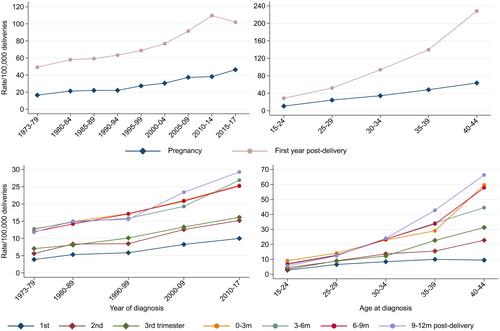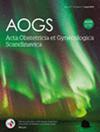Risk factors for the increasing incidence of pregnancy-associated cancer in Sweden – a population-based study
Abstract
Introduction
The incidence of cancer during pregnancy and within first year post-delivery, ie pregnancy-associated cancer (PAC), is increasing in many countries, but little is known about risk factors for these trends. This study quantified incidence of PAC by trimesters and post-delivery periods, and assessed the role of maternal age, parity, immigrant status, education, smoking and body mass index for the risk and incidence trends of PAC.
Material and methods
We used data from the national birth and cancer registers in Sweden during 1973–2017 to define a register-based cohort of women aged 15–44 years. Incidence rates of PAC during pregnancy and up to 1 year post-delivery were calculated per 100 000 deliveries per year. Poisson regression with multiple imputation estimated incidence rate ratios with 95% confidence intervals adjusted by year, age, previous parity, immigrant status, education, smoking and BMI during 1990–2017, when information on risk factors was available.
Results
Among 4 557 284 deliveries, a total of 1274 (during pregnancy) and 3355 (within 1 year post-delivery) cases of PAC were diagnosed, with around 50 cases/year diagnosed during pregnancy and 110 cases/year during the first year post-delivery in the latest period 2015–2017. The most common cancer types during pregnancy were malignant melanoma, breast and cervical cancer, together accounting for 57% of cases during pregnancy and 53% during the first year post-delivery. The numbers of PAC were lower during pregnancy than during post-delivery for all tumor types with lowest numbers during first trimester. The PAC incidence rates increased over calendar time. High maternal age at diagnosis, smoking, nulliparity and non-immigrant background were associated with significantly higher risks of PAC. The increasing PAC incidence was in part explained by higher maternal age over time, but not by the other factors.
Conclusions
High maternal age is the strongest risk factor for PAC. We show for the first time that smoking, nulliparity and non-immigrant background are also contributing risk factors for PAC. However, only high maternal age contributed significantly to the increasing incidence. Further studies on other potential risk factors for PAC are warranted, since our results indicate that age on its own does not fully explain the increase.


 求助内容:
求助内容: 应助结果提醒方式:
应助结果提醒方式:


